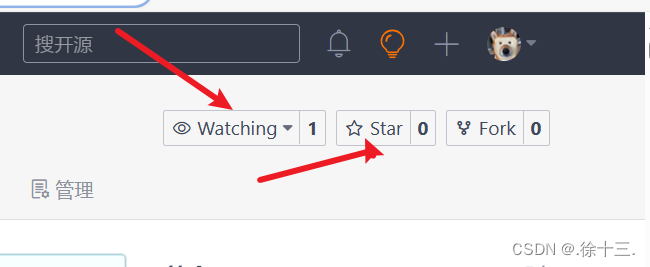最新版本Vue3的学习笔记-第三章(下部)
最新版本Vue3的学习笔记-第一章
最新版本Vue3的学习笔记-第二章
最新版本Vue3的学习笔记-(上部)
最新版本Vue3的学习笔记-第三章(下部)
3.9.【watch】
- 作用:监视数据的变化(和
Vue2中的watch作用一致) - 特点:
Vue3中的watch只能监视以下四种数据:
ref定义的数据。reactive定义的数据。- 函数返回一个值(
getter函数)。- 一个包含上述内容的数组。
我们在Vue3中使用watch的时候,通常会遇到以下几种情况:
* 情况一
监视ref定义的【基本类型】数据:直接写数据名即可,监视的是其value值的改变。
<template>
<div class="person">
<h1>情况一:监视【ref】定义的【基本类型】数据</h1>
<h2>当前求和为:{{sum}}</h2>
<button @click="changeSum">点我sum+1</button>
</div>
</template>
<script lang="ts" setup name="Person">
import {ref,watch} from 'vue'
// 数据
let sum = ref(0)
// 方法
function changeSum(){
sum.value += 1
}
// 监视,情况一:监视【ref】定义的【基本类型】数据
const stopWatch = watch(sum,(newValue,oldValue)=>{
console.log('sum变化了',newValue,oldValue)
if(newValue >= 10){
stopWatch()
}
})
</script>
* 情况二
监视ref定义的【对象类型】数据:直接写数据名,监视的是对象的【地址值】,若想监视对象内部的数据,要手动开启深度监视。
注意:
若修改的是
ref定义的对象中的属性,newValue和oldValue都是新值,因为它们是同一个对象。若修改整个
ref定义的对象,newValue是新值,oldValue是旧值,因为不是同一个对象了。
<template>
<div class="person">
<h1>情况二:监视【ref】定义的【对象类型】数据</h1>
<h2>姓名:{{ person.name }}</h2>
<h2>年龄:{{ person.age }}</h2>
<button @click="changeName">修改名字</button>
<button @click="changeAge">修改年龄</button>
<button @click="changePerson">修改整个人</button>
</div>
</template>
<script lang="ts" setup name="Person">
import {ref,watch} from 'vue'
// 数据
let person = ref({
name:'张三',
age:18
})
// 方法
function changeName(){
person.value.name += '~'
}
function changeAge(){
person.value.age += 1
}
function changePerson(){
person.value = {name:'李四',age:90}
}
/*
监视,情况一:监视【ref】定义的【对象类型】数据,监视的是对象的地址值,若想监视对象内部属性的变化,需要手动开启深度监视
watch的第一个参数是:被监视的数据
watch的第二个参数是:监视的回调
watch的第三个参数是:配置对象(deep、immediate等等.....)
*/
watch(person,(newValue,oldValue)=>{
console.log('person变化了',newValue,oldValue)
},{deep:true})
</script>
* 情况三
监视reactive定义的【对象类型】数据,且默认开启了深度监视。
<template>
<div class="person">
<h1>情况三:监视【reactive】定义的【对象类型】数据</h1>
<h2>姓名:{{ person.name }}</h2>
<h2>年龄:{{ person.age }}</h2>
<button @click="changeName">修改名字</button>
<button @click="changeAge">修改年龄</button>
<button @click="changePerson">修改整个人</button>
<hr>
<h2>测试:{{obj.a.b.c}}</h2>
<button @click="test">修改obj.a.b.c</button>
</div>
</template>
<script lang="ts" setup name="Person">
import {reactive,watch} from 'vue'
// 数据
let person = reactive({
name:'张三',
age:18
})
let obj = reactive({
a:{
b:{
c:666
}
}
})
// 方法
function changeName(){
person.name += '~'
}
function changeAge(){
person.age += 1
}
function changePerson(){
Object.assign(person,{name:'李四',age:80})
}
function test(){
obj.a.b.c = 888
}
// 监视,情况三:监视【reactive】定义的【对象类型】数据,且默认是开启深度监视的
watch(person,(newValue,oldValue)=>{
console.log('person变化了',newValue,oldValue)
})
watch(obj,(newValue,oldValue)=>{
console.log('Obj变化了',newValue,oldValue)
})
</script>
* 情况四
监视ref或reactive定义的【对象类型】数据中的某个属性,注意点如下:
- 若该属性值不是【对象类型】,需要写成函数形式。
- 若该属性值是依然是【对象类型】,可直接编,也可写成函数,建议写成函数。
结论:监视的要是对象里的属性,那么最好写函数式,注意点:若是对象监视的是地址值,需要关注对象内部,需要手动开启深度监视。
<template>
<div class="person">
<h1>情况四:监视【ref】或【reactive】定义的【对象类型】数据中的某个属性</h1>
<h2>姓名:{{ person.name }}</h2>
<h2>年龄:{{ person.age }}</h2>
<h2>汽车:{{ person.car.c1 }}、{{ person.car.c2 }}</h2>
<button @click="changeName">修改名字</button>
<button @click="changeAge">修改年龄</button>
<button @click="changeC1">修改第一台车</button>
<button @click="changeC2">修改第二台车</button>
<button @click="changeCar">修改整个车</button>
</div>
</template>
<script lang="ts" setup name="Person">
import {reactive,watch} from 'vue'
// 数据
let person = reactive({
name:'张三',
age:18,
car:{
c1:'奔驰',
c2:'宝马'
}
})
// 方法
function changeName(){
person.name += '~'
}
function changeAge(){
person.age += 1
}
function changeC1(){
person.car.c1 = '奥迪'
}
function changeC2(){
person.car.c2 = '大众'
}
function changeCar(){
person.car = {c1:'雅迪',c2:'爱玛'}
}
// 监视,情况四:监视响应式对象中的某个属性,且该属性是基本类型的,要写成函数式
/* watch(()=> person.name,(newValue,oldValue)=>{
console.log('person.name变化了',newValue,oldValue)
}) */
// 监视,情况四:监视响应式对象中的某个属性,且该属性是对象类型的,可以直接写,也能写函数,更推荐写函数
watch(()=>person.car,(newValue,oldValue)=>{
console.log('person.car变化了',newValue,oldValue)
},{deep:true})
</script>
* 情况五
监视上述的多个数据
<template>
<div class="person">
<h1>情况五:监视上述的多个数据</h1>
<h2>姓名:{{ person.name }}</h2>
<h2>年龄:{{ person.age }}</h2>
<h2>汽车:{{ person.car.c1 }}、{{ person.car.c2 }}</h2>
<button @click="changeName">修改名字</button>
<button @click="changeAge">修改年龄</button>
<button @click="changeC1">修改第一台车</button>
<button @click="changeC2">修改第二台车</button>
<button @click="changeCar">修改整个车</button>
</div>
</template>
<script lang="ts" setup name="Person">
import {reactive,watch} from 'vue'
// 数据
let person = reactive({
name:'张三',
age:18,
car:{
c1:'奔驰',
c2:'宝马'
}
})
// 方法
function changeName(){
person.name += '~'
}
function changeAge(){
person.age += 1
}
function changeC1(){
person.car.c1 = '奥迪'
}
function changeC2(){
person.car.c2 = '大众'
}
function changeCar(){
person.car = {c1:'雅迪',c2:'爱玛'}
}
// 监视,情况五:监视上述的多个数据
watch([()=>person.name,person.car],(newValue,oldValue)=>{
console.log('person.car变化了',newValue,oldValue)
},{deep:true})
</script>
3.10. 【watchEffect】
-
官网:立即运行一个函数,同时响应式地追踪其依赖,并在依赖更改时重新执行该函数。
-
watch对比watchEffect-
都能监听响应式数据的变化,不同的是监听数据变化的方式不同
-
watch:要明确指出监视的数据 -
watchEffect:不用明确指出监视的数据(函数中用到哪些属性,那就监视哪些属性)。
-
-
示例代码:
<template> <div class="person"> <h1>需求:水温达到50℃,或水位达到20cm,则联系服务器</h1> <h2 id="demo">水温:{{temp}}</h2> <h2>水位:{{height}}</h2> <button @click="changePrice">水温+1</button> <button @click="changeSum">水位+10</button> </div> </template> <script lang="ts" setup name="Person"> import {ref,watch,watchEffect} from 'vue' // 数据 let temp = ref(0) let height = ref(0) // 方法 function changePrice(){ temp.value += 10 } function changeSum(){ height.value += 1 } // 用watch实现,需要明确的指出要监视:temp、height watch([temp,height],(value)=>{ // 从value中获取最新的temp值、height值 const [newTemp,newHeight] = value // 室温达到50℃,或水位达到20cm,立刻联系服务器 if(newTemp >= 50 || newHeight >= 20){ console.log('联系服务器') } }) // 用watchEffect实现,不用 const stopWtach = watchEffect(()=>{ // 室温达到50℃,或水位达到20cm,立刻联系服务器 if(temp.value >= 50 || height.value >= 20){ console.log(document.getElementById('demo')?.innerText) console.log('联系服务器') } // 水温达到100,或水位达到50,取消监视 if(temp.value === 100 || height.value === 50){ console.log('清理了') stopWtach() } }) </script>
3.11. 【标签的 ref 属性】
作用:用于注册模板引用。
用在普通
DOM标签上,获取的是DOM节点。用在组件标签上,获取的是组件实例对象。
用在普通DOM标签上:
<template>
<div class="person">
<h1 ref="title1">十三</h1>
<h2 ref="title2">前端</h2>
<h3 ref="title3">Vue</h3>
<input type="text" ref="inpt"> <br><br>
<button @click="showLog">点我打印内容</button>
</div>
</template>
<script lang="ts" setup name="Person">
import {ref} from 'vue'
let title1 = ref()
let title2 = ref()
let title3 = ref()
function showLog(){
// 通过id获取元素
const t1 = document.getElementById('title1')
// 打印内容
console.log((t1 as HTMLElement).innerText)
console.log((<HTMLElement>t1).innerText)
console.log(t1?.innerText)
/************************************/
// 通过ref获取元素
console.log(title1.value)
console.log(title2.value)
console.log(title3.value)
}
</script>
用在组件标签上:
<!-- 父组件App.vue -->
<template>
<Person ref="ren"/>
<button @click="test">测试</button>
</template>
<script lang="ts" setup name="App">
import Person from './components/Person.vue'
import {ref} from 'vue'
let ren = ref()
function test(){
console.log(ren.value.name)
console.log(ren.value.age)
}
</script>
<!-- 子组件Person.vue中要使用defineExpose暴露内容 -->
<script lang="ts" setup name="Person">
import {ref,defineExpose} from 'vue'
// 数据
let name = ref('张三')
let age = ref(18)
/****************************/
/****************************/
// 使用defineExpose将组件中的数据交给外部
defineExpose({name,age})
</script>
3.12. 【props】
// 定义一个接口,限制每个Person对象的格式 export interface PersonInter { id:string, name:string, age:number } // 定义一个自定义类型Persons export type Persons = Array<PersonInter>
App.vue中代码:<template> <Person :list="persons"/> </template> <script lang="ts" setup name="App"> import Person from './components/Person.vue' import {reactive} from 'vue' import {type Persons} from './types' let persons = reactive<Persons>([ {id:'e98219e12',name:'张三',age:18}, {id:'e98219e13',name:'李四',age:19}, {id:'e98219e14',name:'王五',age:20} ]) </script>
Person.vue中代码:<template> <div class="person"> <ul> <li v-for="item in list" :key="item.id"> {{item.name}}--{{item.age}} </li> </ul> </div> </template> <script lang="ts" setup name="Person"> import {defineProps} from 'vue' import {type PersonInter} from '@/types' // 第一种写法:仅接收 // const props = defineProps(['list']) // 第二种写法:接收+限制类型 // defineProps<{list:Persons}>() // 第三种写法:接收+限制类型+指定默认值+限制必要性 let props = withDefaults(defineProps<{list?:Persons}>(),{ list:()=>[{id:'asdasg01',name:'小猪佩奇',age:18}] }) console.log(props) </script>
3.13. 【生命周期】
-
概念:
Vue组件实例在创建时要经历一系列的初始化步骤,在此过程中Vue会在合适的时机,调用特定的函数,从而让开发者有机会在特定阶段运行自己的代码,这些特定的函数统称为:生命周期钩子 -
规律:
生命周期整体分为四个阶段,分别是:创建、挂载、更新、销毁,每个阶段都有两个钩子,一前一后。
-
Vue2的生命周期创建阶段:
beforeCreate、created挂载阶段:
beforeMount、mounted更新阶段:
beforeUpdate、updated销毁阶段:
beforeDestroy、destroyed -
Vue3的生命周期创建阶段:
setup挂载阶段:
onBeforeMount、onMounted更新阶段:
onBeforeUpdate、onUpdated卸载阶段:
onBeforeUnmount、onUnmounted -
常用的钩子:
onMounted(挂载完毕)、onUpdated(更新完毕)、onBeforeUnmount(卸载之前) -
示例代码:
<template> <div class="person"> <h2>当前求和为:{{ sum }}</h2> <button @click="changeSum">点我sum+1</button> </div> </template> <!-- vue3写法 --> <script lang="ts" setup name="Person"> import { ref, onBeforeMount, onMounted, onBeforeUpdate, onUpdated, onBeforeUnmount, onUnmounted } from 'vue' // 数据 let sum = ref(0) // 方法 function changeSum() { sum.value += 1 } console.log('setup') // 生命周期钩子 onBeforeMount(()=>{ console.log('挂载之前') }) onMounted(()=>{ console.log('挂载完毕') }) onBeforeUpdate(()=>{ console.log('更新之前') }) onUpdated(()=>{ console.log('更新完毕') }) onBeforeUnmount(()=>{ console.log('卸载之前') }) onUnmounted(()=>{ console.log('卸载完毕') }) </script>
3.14. 【自定义hook】
-
什么是
hook?—— 本质是一个函数,把setup函数中使用的Composition API进行了封装,类似于vue2.x中的mixin。 -
自定义
hook的优势:复用代码, 让setup中的逻辑更清楚易懂。
示例代码:
-
useSum.ts中内容如下:import {ref,onMounted} from 'vue' export default function(){ let sum = ref(0) const increment = ()=>{ sum.value += 1 } const decrement = ()=>{ sum.value -= 1 } onMounted(()=>{ increment() }) //向外部暴露数据 return {sum,increment,decrement} } -
useDog.ts中内容如下:import {reactive,onMounted} from 'vue' import axios,{AxiosError} from 'axios' export default function(){ let dogList = reactive<string[]>([]) // 方法 async function getDog(){ try { // 发请求 let {data} = await axios.get('https://dog.ceo/api/breed/pembroke/images/random') // 维护数据 dogList.push(data.message) } catch (error) { // 处理错误 const err = <AxiosError>error console.log(err.message) } } // 挂载钩子 onMounted(()=>{ getDog() }) //向外部暴露数据 return {dogList,getDog} } -
组件中具体使用:
<template> <h2>当前求和为:{{sum}}</h2> <button @click="increment">点我+1</button> <button @click="decrement">点我-1</button> <hr> <img v-for="(u,index) in dogList.urlList" :key="index" :src="(u as string)"> <span v-show="dogList.isLoading">加载中......</span><br> <button @click="getDog">再来一只狗</button> </template> <script lang="ts"> import {defineComponent} from 'vue' export default defineComponent({ name:'App', }) </script> <script setup lang="ts"> import useSum from './hooks/useSum' import useDog from './hooks/useDog' let {sum,increment,decrement} = useSum() let {dogList,getDog} = useDog() </script>
项目源码有帮助到你的,清点个小星星
本文来自互联网用户投稿,该文观点仅代表作者本人,不代表本站立场。本站仅提供信息存储空间服务,不拥有所有权,不承担相关法律责任。 如若内容造成侵权/违法违规/事实不符,请联系我的编程经验分享网邮箱:chenni525@qq.com进行投诉反馈,一经查实,立即删除!